I have been, or can be if you click on a link and make a purchase, compensated via a cash payment, gift, or something else of value for writing this post. As an Amazon Associate, I earn from qualifying purchases. Please read my full Affiliate Disclosure for more information.
Have you ever felt that a space radiates calm and authenticity simply because it embraces imperfection? That’s the magic of Wabi sabi interior design—a Japanese aesthetic that celebrates natural beauty, subtle flaws, and the serenity found in simplicity. Its popularity is soaring because more people are craving spaces that feel genuine, grounding, and free from overly polished perfection.
Wabi sabi invites us to slow down, appreciate the charm of aged materials, and create environments that nurture mindfulness and peacefulness. In this article, you’ll discover a treasure trove of inspiring ideas to bring Wabi sabi’s serene harmony into your home.
From textured walls and weathered furniture to soft lighting and handcrafted accents, each tip is designed to spark your creativity and help you craft a space that exudes tranquility. Whether you’re a seasoned decorator or just starting to explore this aesthetic, you’ll find practical, beautiful ways to incorporate natural materials, imperfect finishes, and minimalist elegance—all in pursuit of a truly harmonious home.
1. Embrace Imperfect Textured Walls with Natural Plaster Finishes
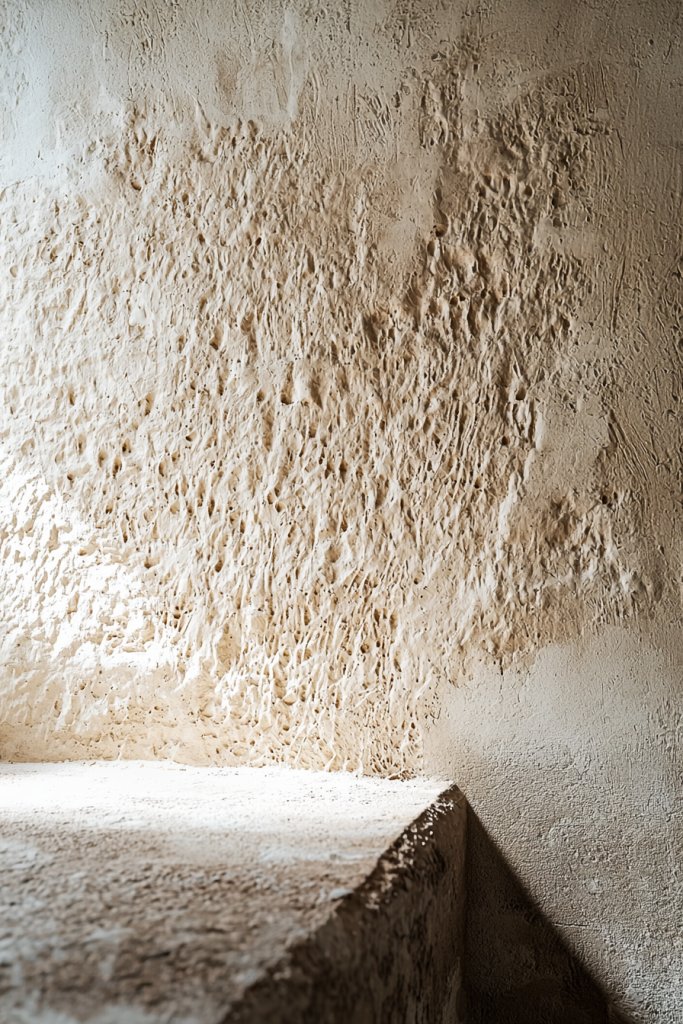
Creating walls with natural, imperfect textures is a cornerstone of wabi sabi interior design, evoking a sense of organic authenticity and tactile warmth. These textured surfaces break away from smooth, uniform finishes, celebrating the beauty of subtle imperfections and irregularities.
Recommended Products to replicate this idea
| # | Preview | Product | |
|---|---|---|---|
| 1 |

|
Meoded Paint & Plaster | Golmex Concrete Look Plaster | Lime/Cement Based Plaster for Interior... | Check Latest Price |
| # | Preview | Product | |
|---|---|---|---|
| 1 |

|
ESreake 2 Pcs Masonry Hand Tool Set, 6" Pointing & Gauging Trowel Set with Soft Grip Handle | Check Latest Price |
They add visual interest and depth to a space, making it feel both cozy and rooted in nature. Imagine walking into a room where the walls have a soft, uneven surface with gentle ridges and a matte, slightly grainy finish.
The color palette is often earthy—warm beiges, muted greys, or soft browns—allowing light to softly dance across the textured surface, creating gentle shadows. The tactile quality invites you to run your fingers over the walls, enhancing the sensory experience.
The natural plaster’s subtle imperfections lend a handcrafted, timeless vibe that complements other wabi sabi elements like aged wood or organic textiles. To achieve this look, start by applying a natural lime or clay plaster onto your walls using a trowel or spatula, intentionally creating uneven patches and textures.
You can opt for DIY plaster kits available at home improvement stores or hire a professional for a seamless finish. Keep the color simple—earth tones or muted shades—to maintain harmony. Finish with a matte sealant if desired, and embrace the organic, imperfect beauty that naturally develops over time.
2. Incorporate Weathered Wood Furniture for Rustic Charm
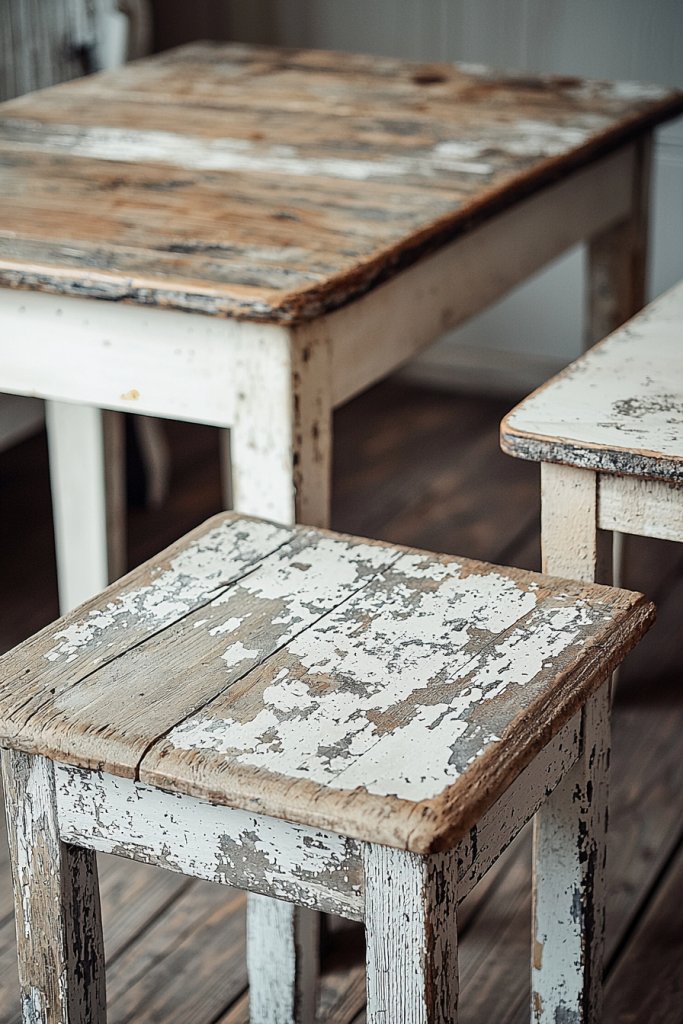
Weathered wood furniture embodies the wabi sabi philosophy by showcasing the natural aging process and imperfections that tell a story of history and authenticity. Pieces with distressed paint, worn edges, or visible grain imperfections add rustic charm and a sense of timelessness to any space.
Recommended Products to replicate this idea
| # | Preview | Product | |
|---|---|---|---|
| 1 |

|
Merrick Lane Jessamine 60" x 38" Rectangular Rustic Solid Pine Farm Dining Table, Antique... | Check Latest Price |
| # | Preview | Product | |
|---|---|---|---|
| 1 |

|
VASAGLE Dining Chair Set of 2, Rustic Wood Chairs with Metal Steel Frame, Easy to Assemble,... | Check Latest Price |
These elements create a warm, inviting atmosphere rooted in nature’s cycles. Picture a sturdy dining table with a surface marked by gentle scratches and faded paint, paired with a set of chairs that have chipped edges and uneven finishes.
The wood’s colors range from faded whites and soft greys to rich, warm browns, all bearing the marks of age—cracks, knots, and patina that highlight their unique character. The tactile surface of weathered wood invites touch, adding to the sensory richness of the room.
These pieces feel grounded and imperfect, balancing modern minimalism with natural authenticity. To incorporate weathered wood, look for vintage or reclaimed furniture at thrift stores, flea markets, or specialty shops.
If you prefer new pieces, choose furniture with intentionally distressed finishes or apply a weathering technique yourself using sandpaper, vinegar, or homemade stains. Pair these with natural textiles like linen or hemp for a cohesive, earthy aesthetic. The goal is to embrace imperfections and celebrate the beauty of age, creating a space that feels both timeless and deeply personal.
3. Use Minimalist, Uncluttered Spaces for Calmness
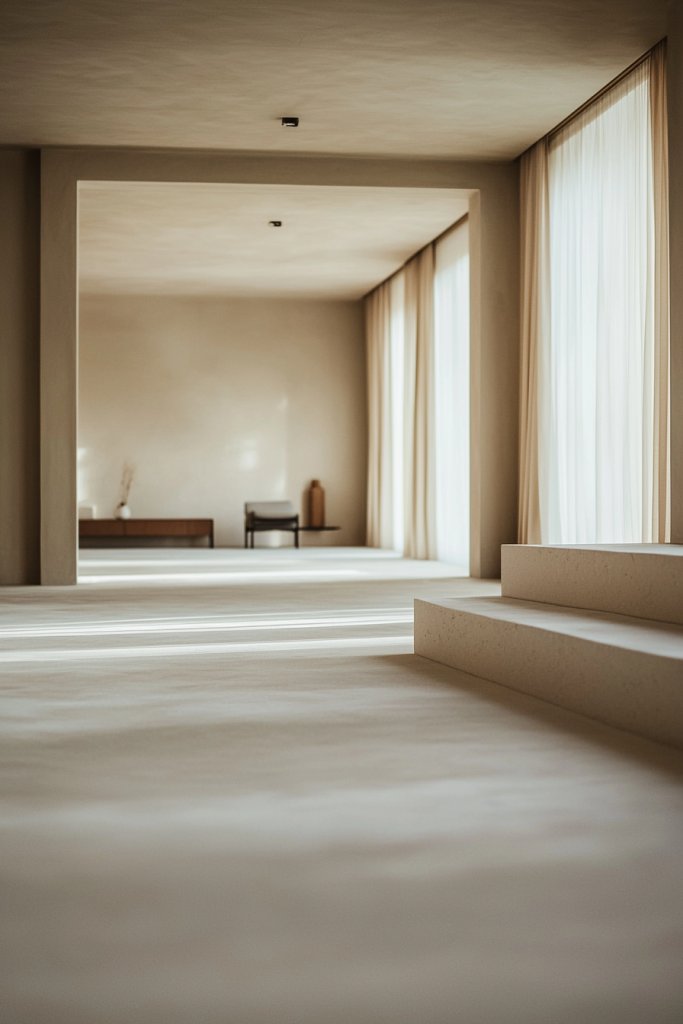
A hallmark of wabi sabi design is simplicity—creating uncluttered, open spaces that foster a sense of calm and mindfulness. By reducing visual noise and focusing on a few meaningful objects, you allow the natural beauty of materials and textures to shine.
Recommended Products to replicate this idea
| # | Preview | Product | |
|---|---|---|---|
| 1 |

|
Vanselia Ceramic Flower Vase Home Decor - Large Farmhouse Table Vases Rustic Vintage Living Room... | Check Latest Price |
| # | Preview | Product | |
|---|---|---|---|
| 1 |

|
Soalmost Washable Area Rug 8x10, Large Soft Rugs for Living Room Vintage Beige Carpet 8x10 Area... | Check Latest Price |
This minimalism encourages tranquility and a slow, contemplative way of living. Envision a room with a sparse layout: a low-profile wooden bench, a single textured ceramic vase, and a soft, neutral-toned rug.
The space feels airy and balanced, with plenty of open floor area and only essential elements. Walls are kept simple, perhaps with a subtle textured finish or a neutral color palette.
The overall atmosphere is quiet and serene, inviting you to breathe deeply and relax. Each element is carefully chosen for its natural imperfection and understated beauty, reminding us that less is more.
To achieve this, start by decluttering and removing unnecessary items. Focus on selecting a few high-quality, imperfect objects—such as a handmade ceramic bowl or a linen throw—in neutral tones.
Use furniture with simple lines, low profiles, and natural materials like wood or stone. Keep surfaces clear and allow negative space to breathe.
Incorporate soft lighting with diffused bulbs or paper lanterns to enhance the calming ambiance. The key is to create a space that feels intentional, peaceful, and authentic, free from excess.
4. Choose Neutral, Earthy Color Palettes for a Soothing Atmosphere
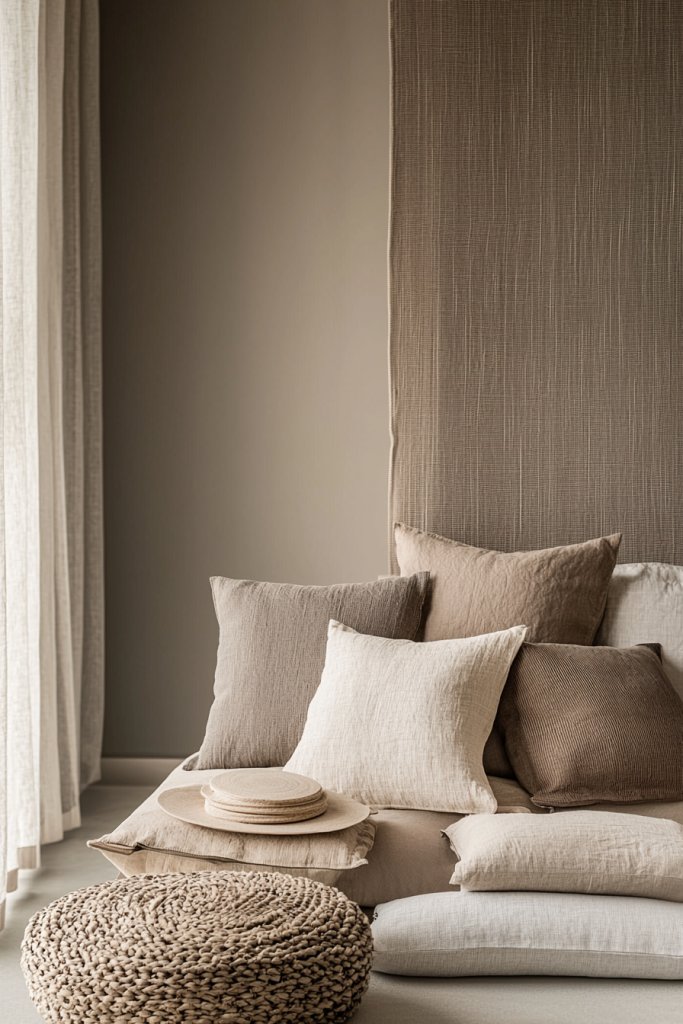
Wabi sabi interiors thrive on subdued, natural colors that evoke a sense of calm and harmony with nature. Soft beiges, warm greys, muted browns, and gentle creams form a serene palette that creates a cozy, grounded environment.
Recommended Products to replicate this idea
| # | Preview | Product | |
|---|---|---|---|
| 1 |

|
EVOLVE Paint & Primer: Environment-friendly, Low Sheen with One-coat Coverage for Interior &... | Check Latest Price |
| # | Preview | Product | |
|---|---|---|---|
| 1 |

|
NICETOWN Natural Linen Curtains 84 inch Long 2 Panels Set, Grommet Top Thick Linen Burlap Semi... | Check Latest Price |
These hues serve as a calming backdrop that emphasizes texture and imperfection. Imagine a living room painted in a warm, sandy beige, complemented by furniture in soft grey linen and accents in deep, earthy browns.
The colors are understated but rich in their natural appeal, allowing light to bounce softly across surfaces and highlighting the varied textures—whether rough plaster walls or smooth ceramic vases. The overall effect is a peaceful space that feels both warm and balanced, reminiscent of natural landscapes and weathered stones.
To incorporate this palette, select wall paints, textiles, and furnishings in these muted tones. Opt for natural dyes or low-VOC paints to enhance sustainability.
Use layered textures—like a woven jute rug, linen curtains, or wool throws—to add depth and tactile interest. Keep accessories minimal, focusing on organic forms and natural finishes. This neutral color scheme provides a tranquil canvas that nurtures mindfulness and serenity, perfectly aligning with wabi sabi principles.
5. Integrate Handmade Ceramics and Pottery as Decorative Accents
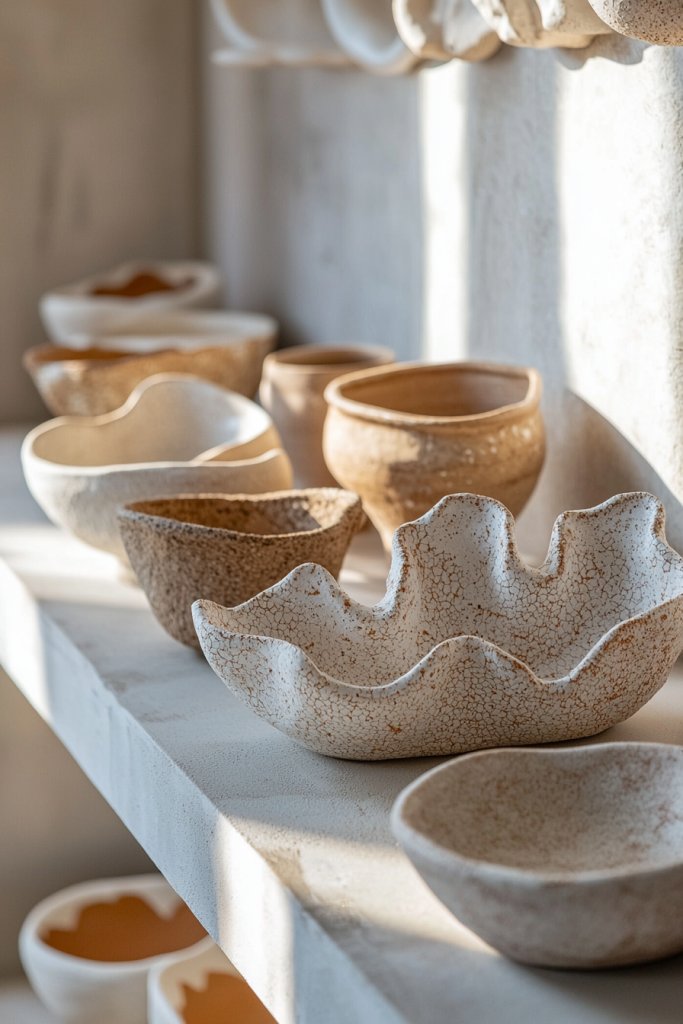
Artisan-made ceramics and pottery are essential to wabi sabi interiors because they embody handcrafted imperfection and natural beauty. These pieces, with their irregular shapes, textured surfaces, and subtle color variations, serve as tactile focal points that enhance the organic, imperfect aesthetic.
Recommended Products to replicate this idea
| # | Preview | Product | |
|---|---|---|---|
| 1 |

|
Creative Co-Op Stoneware Bowl w Reactive Glaze, White | Check Latest Price |
| # | Preview | Product | |
|---|---|---|---|
| 1 |

|
Mulberry Lane Co. Handmade Black Vase - 9.5'' Tall, Black Ceramic Vase, Antique Decor with 3 Ear... | Check Latest Price |
Picture a series of uneven, hand-thrown bowls with raw clay textures and glaze drips, displayed on open shelves or used as tabletop accents. The colors are often earthy—muted browns, soft creams, or smoky greys—complementing the surrounding natural materials.
The irregularities in shape and finish evoke a sense of human touch and authenticity, making each piece unique. These ceramics bring warmth and character, subtly reminding us of the beauty in imperfection and craftsmanship.
To incorporate handmade ceramics, seek out local artisans, craft markets, or online shops specializing in artisanal pottery. You can start with a few simple pieces—such as a mug, a vase, or a shallow bowl—and mix and match textures and shapes.
Place them thoughtfully on open shelves, side tables, or as centerpieces. If you’re feeling creative, try DIY pottery classes or simple clay projects at home. The result is a collection of functional art that adds tactile richness and a sense of soulful imperfection to your space.
6. Incorporate Worn Leather or Linen Textiles for Natural Comfort
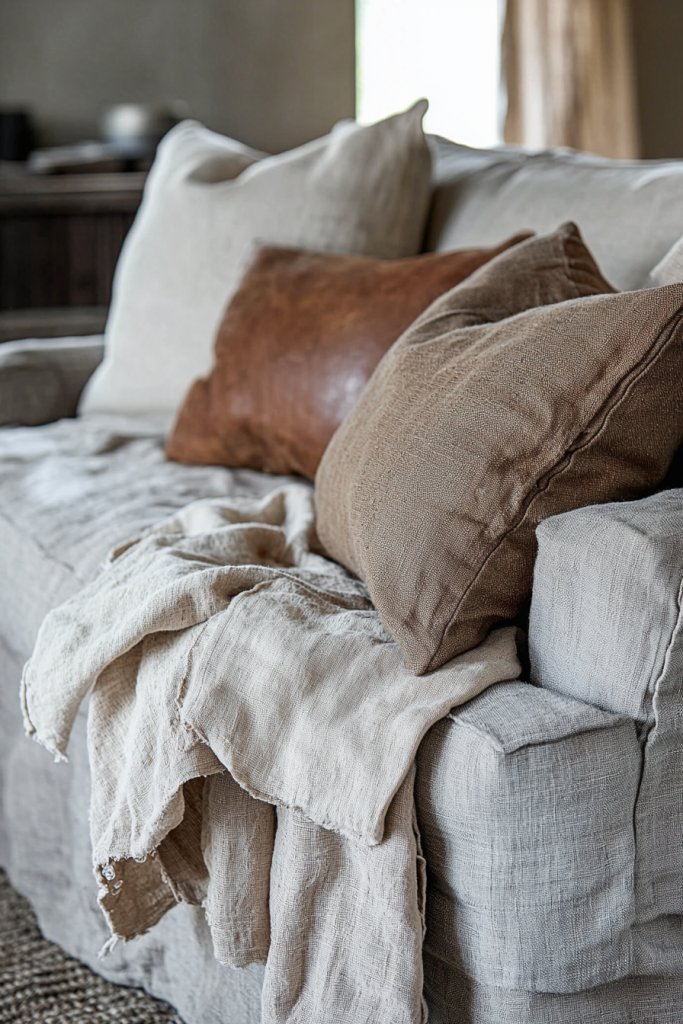
In Wabi Sabi interior design, tactile warmth and authenticity are key, and nothing embodies this more than natural textiles like worn leather and linen. These materials add a sense of lived-in comfort that feels both inviting and effortlessly elegant, perfectly aligning with the philosophy of embracing imperfection.
Recommended Products to replicate this idea
| # | Preview | Product | |
|---|---|---|---|
| 1 |

|
Bedsure 100% Cotton Muslin Throw Blanket Large 50x70 Inches - 4-Layer Breathable and Lightweight... | Check Latest Price |
| # | Preview | Product | |
|---|---|---|---|
| 1 |

|
FiveWillowise Square Leather Ottoman with Storage, Leather Coffee Table Ottoman with Lift Top,... | Check Latest Price |
Using them in your space can create a cozy, grounding atmosphere that invites relaxation. Imagine a plush linen throw draped over a rustic wooden armchair, its slightly rumpled texture hinting at years of gentle use.
A vintage leather ottoman with soft creases and a weathered patina sits beside it, radiating character and history. The neutral tones—creamy beiges, soft browns, and muted greys—blend seamlessly with natural light filtering through linen curtains, while the subtle imperfections in these textiles evoke a sense of authenticity.
The tactile experience is gentle and calming, inviting you to touch and settle in. To incorporate these textiles, start by selecting linen cushions or throws with natural, slightly irregular weaves that add visual interest.
Look for vintage or distressed leather pieces, which can often be found at thrift stores or specialty shops. Pair a simple linen slipcover with a well-worn leather pouf or chair to achieve the ideal balance of comfort and rustic charm. These textiles are easy to integrate into any space and require minimal maintenance, making them a practical way to add warmth and character.
7. Feature Asymmetrical Shelving for Visual Interest
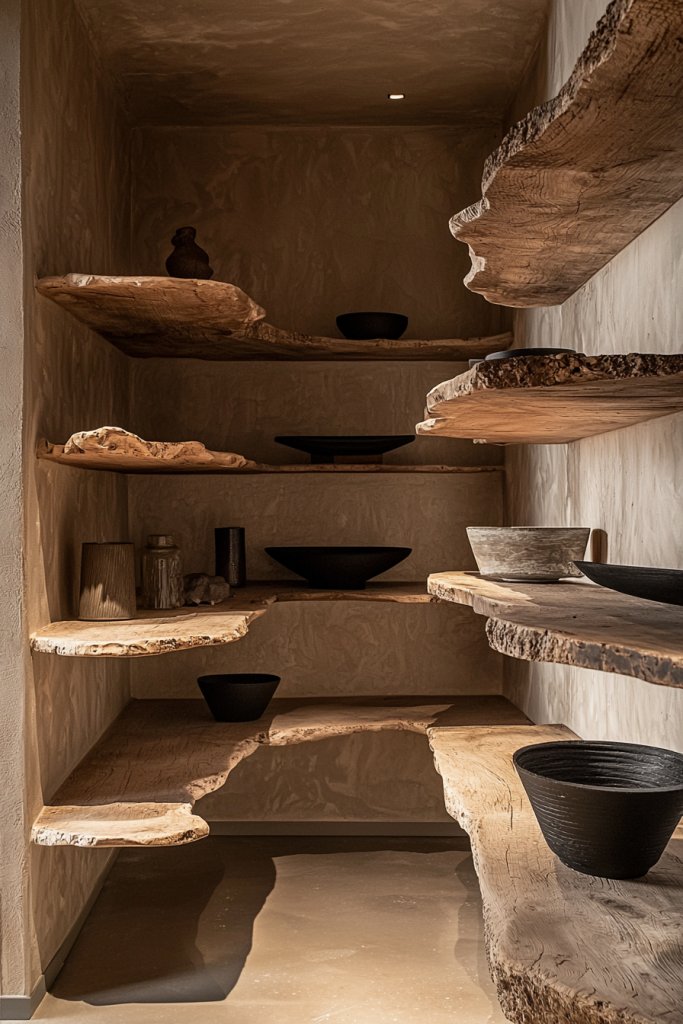
Asymmetrical shelving introduces a playful yet balanced element into Wabi Sabi interiors, emphasizing the beauty of imperfection while creating a dynamic focal point. Unlike perfectly aligned units, these shelves break the monotony, drawing the eye and showcasing curated collections of simple, meaningful objects with authenticity and charm.
Recommended Products to replicate this idea
| # | Preview | Product | |
|---|---|---|---|
| 1 |

|
DUMOS 5 Tiers Bookshelf, Classical Modern Book Shelf, Tall Display Shelves in Living... | Check Latest Price |
| # | Preview | Product | |
|---|---|---|---|
| 1 |

|
PORCER 8.2 Inch Ceramic Vase, Terracotta Rustic Vase Farmhouse Decorative Vase Boho Decor,... | Check Latest Price |
Visualize a set of open wooden shelves arranged in an irregular pattern on a weathered brick wall. The shelves hold an eclectic mix of ceramic bowls, handmade vases, and small sculptures, each with unique shapes and textures.
The asymmetry creates a sense of spontaneous beauty, with some shelves slightly higher or lower, giving a relaxed and organic feel. The natural wood’s rough grain adds warmth, contrasting with the subtle imperfections of the objects displayed.
This arrangement invites curiosity and encourages slow, mindful appreciation of each piece. To implement this, start by selecting simple wooden planks or reclaimed wood for the shelves.
Use brackets or mounting hardware that are minimal and unobtrusive. Arrange the shelves in a non-uniform pattern—think of it as a visual dance—before fixing them to ensure a balanced composition.
Curate a collection of handmade ceramics, vintage objects, or natural materials that speak to you. This approach is beginner-friendly, and the imperfect, handcrafted look is inherently forgiving of mistakes, making it an accessible way to add visual interest.
8. Add Natural Stone Elements for Grounding and Balance
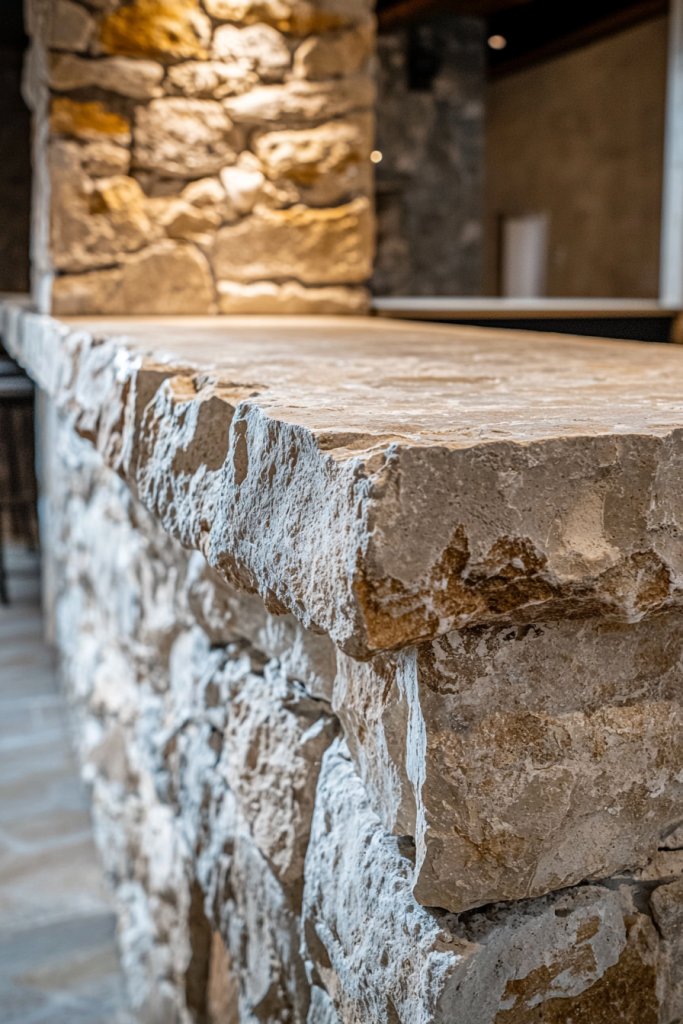
In Wabi Sabi design, raw, unpolished stone elements serve as anchors that foster a sense of stability and connection to nature. Incorporating natural stone—whether through countertops, flooring, or decorative accents—enhances the space’s organic feel and celebrates the beauty of raw, imperfect textures.
Recommended Products to replicate this idea
| # | Preview | Product | |
|---|---|---|---|
| 1 |

|
Daddy Van's® All Natural Beeswax Countertop Care for Soapstone, Slate, Concrete Composite and... | Check Latest Price |
| # | Preview | Product | |
|---|---|---|---|
| 1 |

|
FANTIAN 20 lbs Natural River Rocks Mexican Beach Pebbles, 2-3 Inch Decorative River Rocks for... | Check Latest Price |
Picture a kitchen with a chunky, rough-hewn stone countertop in shades of slate grey or warm beige. The surface is slightly uneven, with natural pits and crevices that tell a story of earth’s formation.
In the living room, a large, unpolished stone sculpture or a set of small river stones arranged in a bowl adds tactile and visual grounding. The scent of earthy minerals mingles subtly with the air, creating a calming atmosphere.
These elements lend weight and authenticity, emphasizing the natural imperfections that are celebrated in Wabi Sabi aesthetics. To incorporate stone, consider sourcing reclaimed or locally quarried materials for countertops or flooring.
For decorative accents, collect smooth river stones or unpolished rocks and display them in bowls or on shelves. You can also use stone tiles with a rustic, unpolished finish for a more subtle effect. Keep in mind that natural stone can be heavy and requires proper sealing or maintenance, but the effort is rewarded with a space that feels deeply rooted and serene.
9. Utilize Low-Profile, Modular Furniture for a Zen-Like Flow
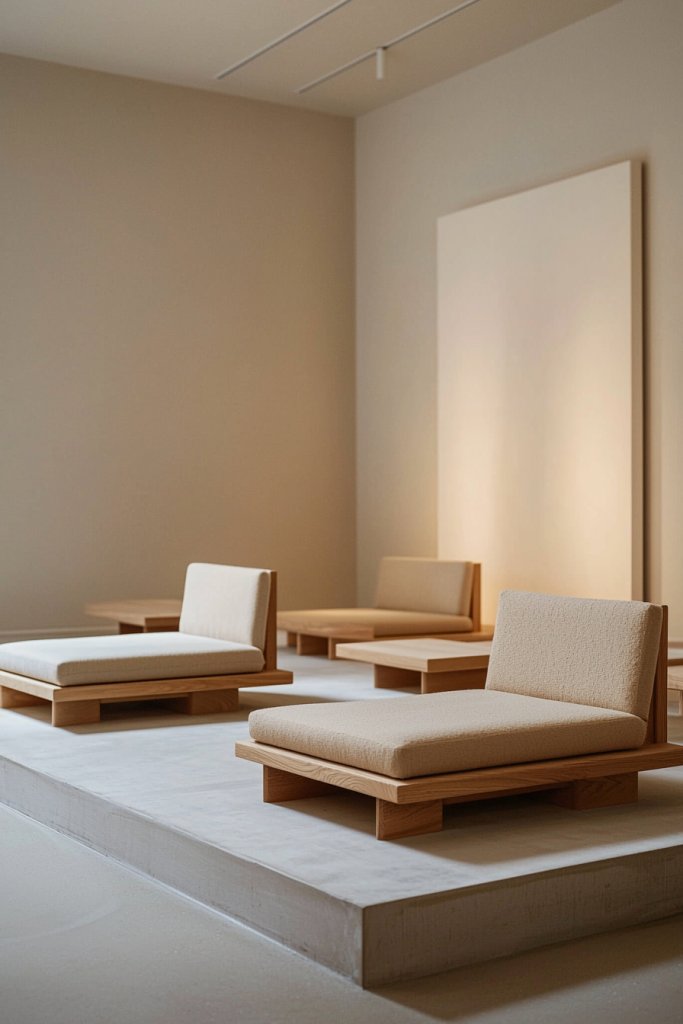
Low-profile, modular furniture embodies the minimalist, harmonious spirit of Wabi Sabi by fostering an open, unobtrusive environment. These pieces encourage a relaxed flow, making the space feel balanced and inviting—a perfect foundation for serenity.
Recommended Products to replicate this idea
| # | Preview | Product | |
|---|---|---|---|
| 1 |

|
Mid-Century Modern Expandable Coffee Table (47.2"-81.8" Adjustable Centerpiece),Center Table with... | Check Latest Price |
| # | Preview | Product | |
|---|---|---|---|
| 1 |

|
108” Modular Sectional Sofa, Cloud Sectional Couch with Deep Seat, Modern Modular L-Shape Sofa... | Check Latest Price |
Imagine a living room with a low wooden coffee table and a modular sofa set with simple, clean lines and soft, neutral upholstery. The furniture sits close to the ground, allowing for easy movement and creating a cozy, intimate atmosphere.
The design emphasizes horizontal lines, which evoke calm and stability, and the lack of ornamentation directs focus to the textures and imperfections of surrounding objects. The overall layout feels effortless, promoting mindfulness and a sense of spaciousness.
To achieve this look, choose furniture with low profiles—think cushions on the floor, low benches, or platform beds—made from natural materials like wood or bamboo. Modular pieces that can be rearranged offer flexibility, allowing you to adapt the space over time.
Keep the palette neutral, with shades of beige, taupe, or grey, and opt for furniture with visible grains and textures to enhance the organic aesthetic. Assembling this type of furniture is straightforward, and it promotes an uncluttered, peaceful environment ideal for relaxation and reflection.
10. Incorporate Wabi Sabi-Inspired Lighting with Soft, Diffused Glow
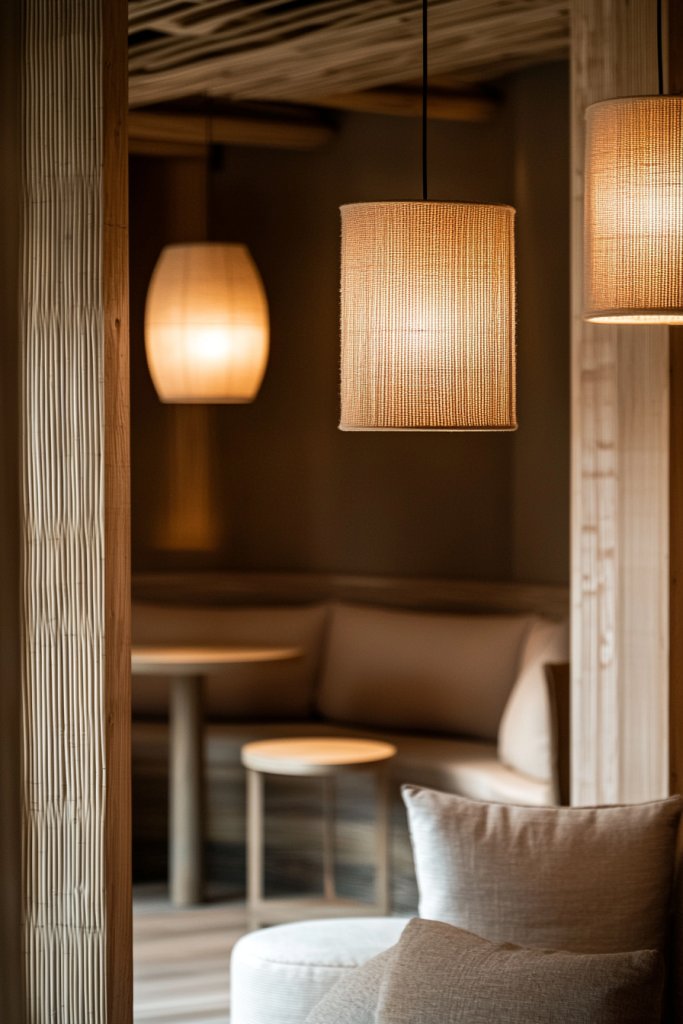
Lighting in Wabi Sabi interiors is about creating a gentle, calming ambiance that highlights the imperfect beauty of natural materials. Soft, diffused light sources evoke a sense of tranquility, making the space feel warm and inviting while emphasizing textures and subtle imperfections.
Recommended Products to replicate this idea
| # | Preview | Product | |
|---|---|---|---|
| 1 |

|
BEISHIDA 10Pcs White Paper Lanterns Decorative Chinese/Japanese Hanging Round Paper Lanterns Lamp... | Check Latest Price |
| # | Preview | Product | |
|---|---|---|---|
| 1 |

|
VELXEE Rattan Table Lamp, Vintage Wicker Wooden Nightstand Lamp Set of 2, Boho Bamboo Woven End... | Check Latest Price |
Picture a room illuminated by a paper lantern or a woven rattan lamp. The light filters through natural fibers or rice paper, casting a warm, gentle glow that softly illuminates textured walls and handcrafted objects.
The lighting’s subdued quality reduces harsh shadows, fostering an atmosphere of quiet serenity. The organic, natural materials of the fixtures themselves—such as wood, bamboo, or clay—further enhance the aesthetic, creating a cohesive, harmonious environment.
To incorporate this idea, select lamps with natural shades made from linen, rice paper, or woven fibers. Place them strategically to create pools of soft light that highlight specific areas, like a reading nook or a cozy corner.
Dimmer switches can help adjust the light’s intensity according to mood and time of day. You can also explore DIY options, such as wrapping a simple bulb with a natural fabric or creating your own paper lanterns. This approach is accessible and instantly transforms the space into a tranquil sanctuary, perfect for unwinding.
11. Display Handcrafted Textiles with Subtle Irregularities
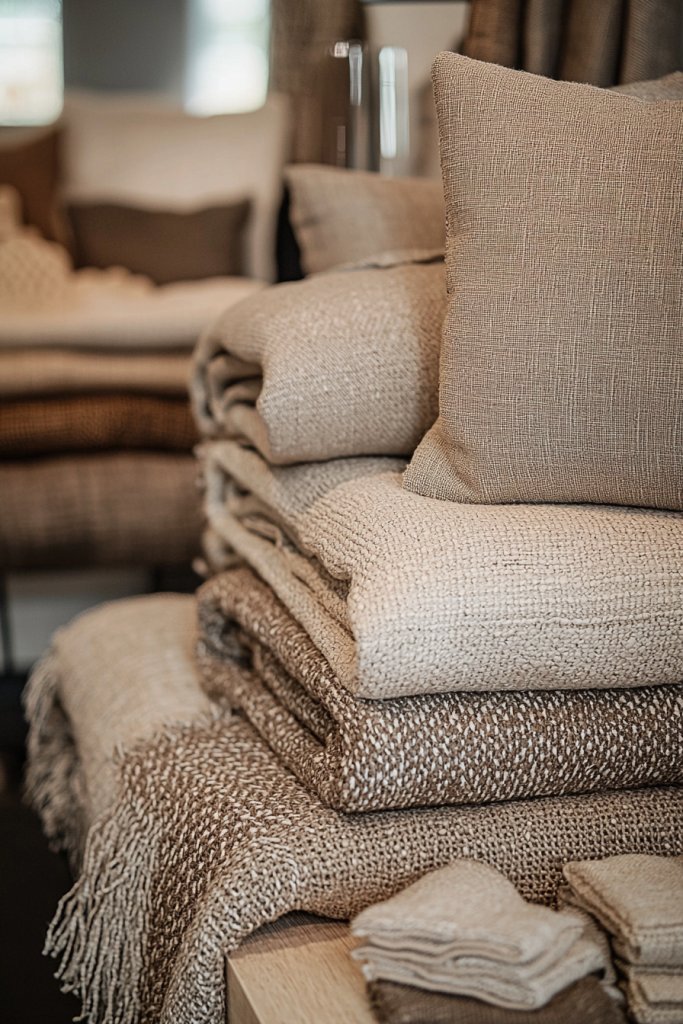
In Wabi Sabi interior design, the beauty of imperfection extends to textiles, adding warmth and authenticity to a space. Showcasing handcrafted fabrics with subtle irregularities celebrates the artisanal process and creates a cozy, lived-in feel that resonates deeply with the philosophy of embracing flaws.
Recommended Products to replicate this idea
| # | Preview | Product | |
|---|---|---|---|
| 1 |

|
Primitives by Kathy Gypsy Hand Woven Wall Hanging, 14" x 25", Yellow/Green, 8541857714 | Check Latest Price |
| # | Preview | Product | |
|---|---|---|---|
| 1 |

|
L'AGRATY Chunky Knit Blanket Throw,Soft Chenille Yarn Throw 50x60,Handmade Thick Cable Knit... | Check Latest Price |
Imagine a soft, woven throw blanket in a natural beige or muted earth tone draped over a low sofa or armchair. The textile might feature slightly uneven weaving patterns, with tiny variations in thread thickness that make each piece unique.
Tactile textures like chunky knits, loosely woven rugs, or handcrafted wall hangings bring a sense of organic imperfection, inviting touch and creating a calming sensory experience. These textiles not only add visual interest but also soften the overall atmosphere, making the space feel more inviting and authentic.
To incorporate this idea, start by sourcing artisanal or handmade textiles from local markets or online craft stores. Look for items like a woven linen wall hanging, a chunky knit throw in natural fiber, or a handwoven rug with irregular patterns.
Drape or layer these textiles in your living space, mixing textures and tones for a harmonious, imperfect look. You can also DIY a simple woven wall hanging using natural yarns and basic macramé techniques, making the process both accessible and rewarding.
12. Feature Functional, Minimalist Storage Solutions in Natural Materials
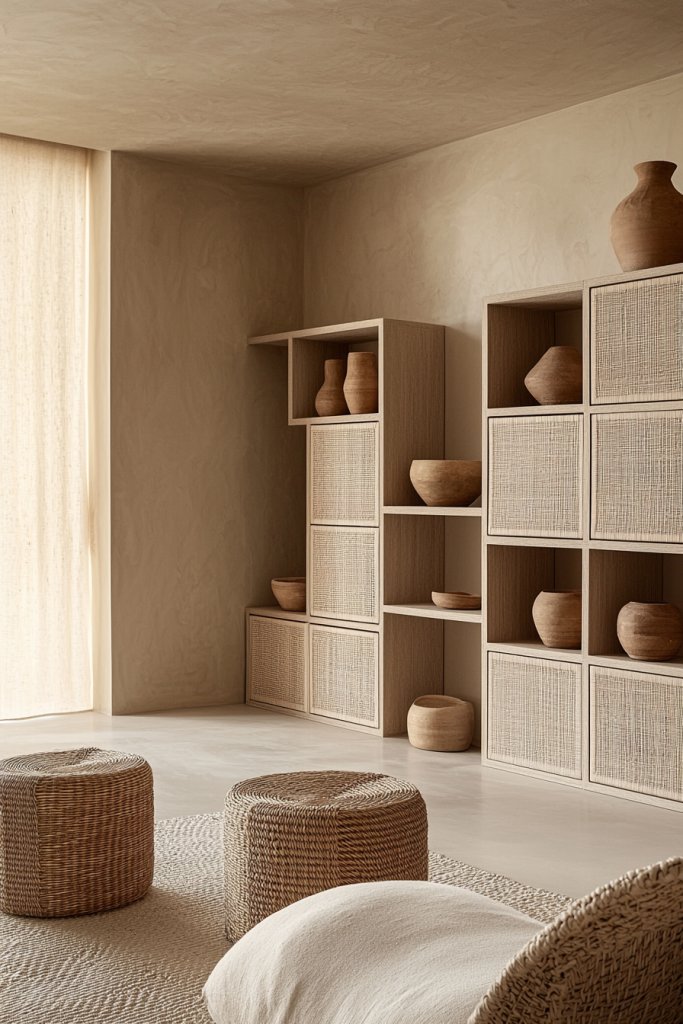
In Wabi Sabi interiors, storage is both practical and aesthetically pleasing, emphasizing simplicity and natural beauty. Using minimalist, functional storage in materials like wood, clay, or woven fibers keeps clutter at bay while enhancing the organic, unpretentious vibe of the space.
Recommended Products to replicate this idea
| # | Preview | Product | |
|---|---|---|---|
| 1 |

|
HOOBRO Toy Box, Retro Wooden Look Storage Chest with Safety Hinge, Entryway Storage Bench... | Check Latest Price |
| # | Preview | Product | |
|---|---|---|---|
| 1 |

|
Happyiren Cute Woven Storage Basket with Handle, Baskets for Gifts Empty, Gift Baskets for... | Check Latest Price |
Visualize open wooden crates stacked neatly in a corner, holding books, blankets, or ceramics. These containers might have rough, unpolished surfaces that reveal the wood’s natural grain or slight imperfections, adding character.
Wicker baskets or clay pots serve as hidden or accessible storage for everyday items, blending seamlessly into the decor. The focus is on clean lines and natural textures that complement the overall serenity, creating a space where form follows function without excess ornamentation.
To bring this into your home, choose simple storage options like unfinished wooden boxes, woven baskets, or clay jars available at craft stores or flea markets. Place them where they are easily accessible—under a console table, beside a reading nook, or open on shelves—to keep essentials organized.
For a DIY touch, you can stain or leave natural small wooden crates or baskets untreated, enjoying the raw, imperfect finish that aligns with Wabi Sabi principles. These solutions are cost-effective, easy to implement, and elevate the honest beauty of your space.
13. Integrate Asymmetrical Arrangements of Decorative Objects
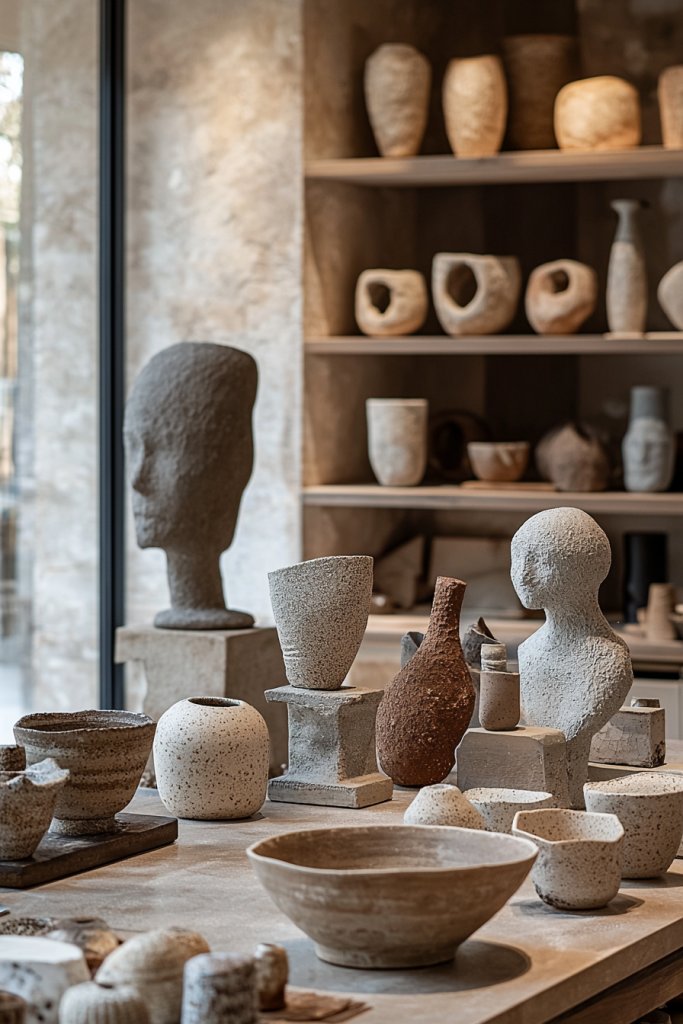
In Wabi Sabi design, asymmetry highlights natural beauty and invites viewers to appreciate the imperfect harmony of arrangements. By thoughtfully placing ceramics, sculptures, or other decor elements in non-uniform patterns, you create a curated, authentic aesthetic that feels both spontaneous and intentional.
Recommended Products to replicate this idea
| # | Preview | Product | |
|---|---|---|---|
| 1 |

|
Vanselia Ceramic Flower Vase Home Decor - Large Farmhouse Table Vases Rustic Vintage Living Room... | Check Latest Price |
| # | Preview | Product | |
|---|---|---|---|
| 1 |

|
Fake Sandstone Statue Home Decor for Living Room, 5.3" W × 10.4" H Modern Resin Stone Sculptures... | Check Latest Price |
Picture a shelf with a collection of handmade ceramic vessels of varying sizes and shapes, spaced unevenly yet balanced visually. Some objects might lean slightly or have irregular contours, emphasizing their handcrafted origin.
The arrangement draws the eye across the display, encouraging a sense of discovery and appreciation for each piece’s unique character. This approach breaks away from rigid symmetry, fostering a relaxed, organic atmosphere where every object seems part of a natural story.
To achieve this look, gather simple objects like ceramic bowls, sculptures, or natural stones. Arrange them on shelves, mantels, or tables in a loose, non-matching pattern—placing larger items asymmetrically and leaving intentional gaps.
Trust your eye to balance the composition without perfect symmetry, and don’t be afraid to move objects around until they feel right. This effortless, imperfect display invites a sense of calm and authenticity, making your space feel thoughtfully imperfect and deeply personal.
14. Incorporate Wabi Sabi-Inspired Window Treatments with Linen or Rice Paper
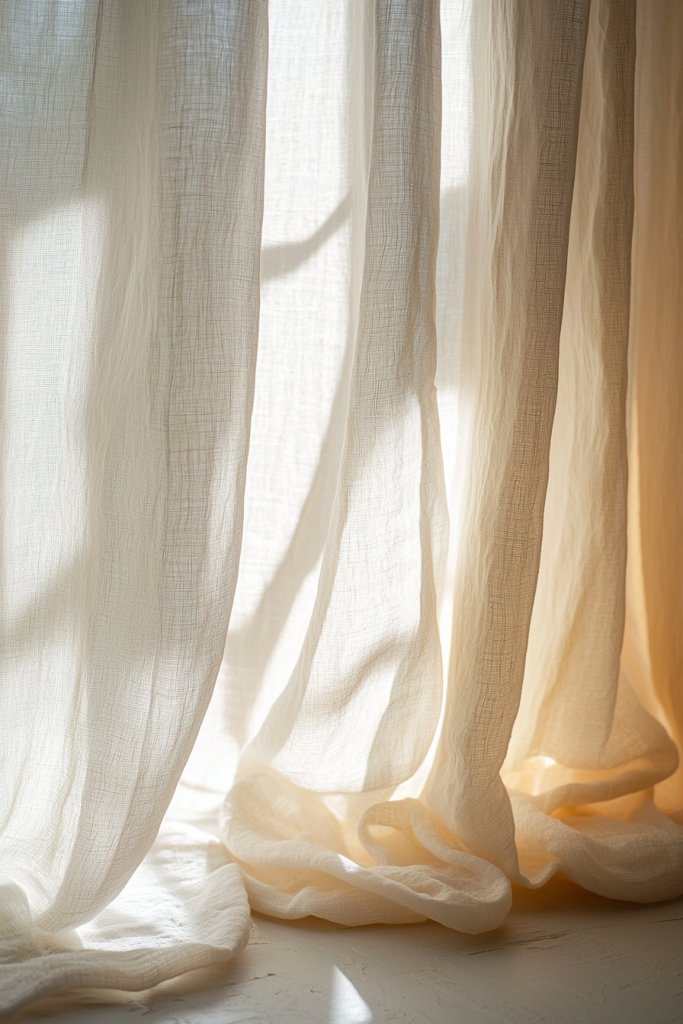
Soft, natural window treatments are essential for creating a tranquil, harmonious atmosphere in Wabi Sabi interiors. Using linen curtains or translucent rice paper panels diffuses light gently, emphasizing the beauty of simplicity and imperfection while enhancing the room’s serenity.
Recommended Products to replicate this idea
| # | Preview | Product | |
|---|---|---|---|
| 1 |

|
NICETOWN Natural Linen Curtains 84 inch Long 2 Panels Set, Grommet Top Thick Linen Burlap Semi... | Check Latest Price |
| # | Preview | Product | |
|---|---|---|---|
| 1 |

|
NicBex Room Divider 3 Panel Room Dividers with Heavy-Duty Rice Paper Partition Room Dividers and... | Check Latest Price |
Visualize sheer, slightly wrinkled linen curtains in muted tones like cream or stone, hanging loosely from simple wooden rods. When closed, they allow a filtered, warm glow to fill the room, softening harsh sunlight and creating a calming ambiance.
Alternatively, rice paper panels—mounted on wooden frames—offer a delicate, almost ethereal quality, with subtle irregularities in the paper that highlight their handmade nature. These treatments gently obscure the view outside while maintaining an airy, open feel that invites peaceful reflection.
To incorporate this idea, opt for natural linen or hemp curtains from eco-friendly stores or craft your own using basic sewing skills. For rice paper panels, purchase pre-made kits and attach them to simple wooden frames or sliding tracks.
Keep window hardware minimal, favoring raw wood or matte finishes to complement the organic aesthetic. This understated approach to window dressing enhances the overall harmony of your space, filling it with gentle light and a sense of quiet simplicity.
15. Use Reclaimed or Vintage Lighting Fixtures for Character
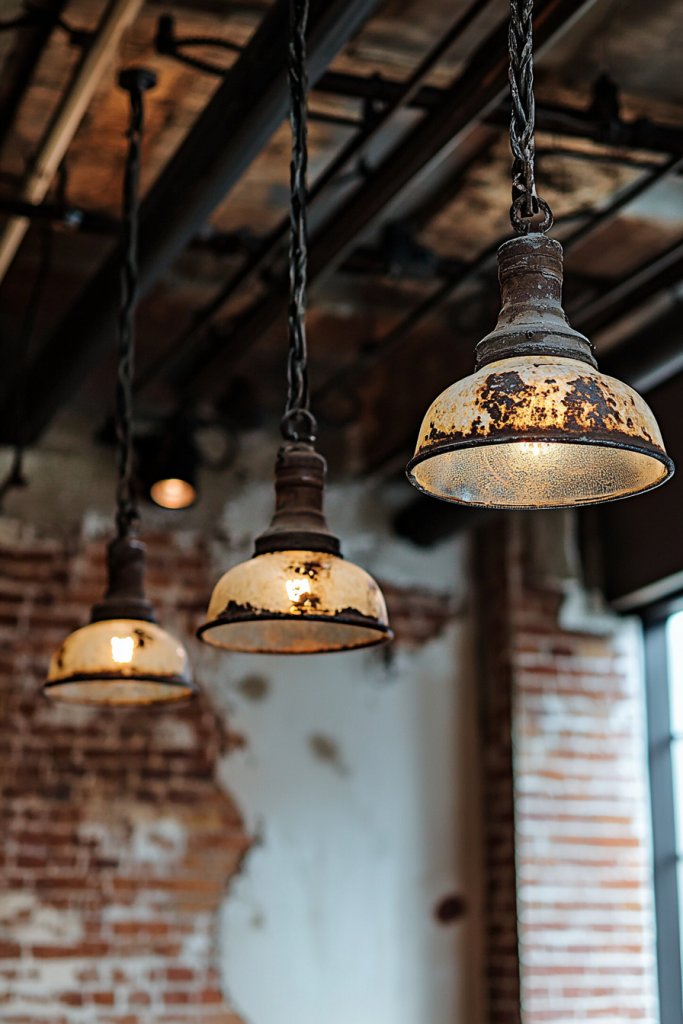
Lighting plays a crucial role in establishing the mood of a Wabi Sabi interior, and vintage or reclaimed fixtures add a layer of history and depth. Fixtures with a patina or aged finish evoke a sense of impermanence and beauty in age, perfectly aligning with the philosophy of embracing natural wear.
Recommended Products to replicate this idea
| # | Preview | Product | |
|---|---|---|---|
| 1 |

|
Shenmoyl Pendant Light with Amber Scindapsus Glass Lmapshade, Brass Vintage Pendant Light... | Check Latest Price |
| # | Preview | Product | |
|---|---|---|---|
| 1 |

|
Deco 79 Reclaimed Wood Indoor/Outdoor Candle Lantern - Beaded Decorative Candle Holder, 13" x 10"... | Check Latest Price |
Imagine a pendant light made from aged brass or a rustic lantern with a weathered iron finish hanging above a dining table. Its uneven surface and subtle tarnish tell a story of time passed, adding character and warmth to the room.
Soft, diffused light from these fixtures creates a cozy, inviting glow that enhances textures and imperfections, making the space feel lived-in and authentic. The combination of old, reclaimed materials and simple design elevates the subtle beauty of imperfection.
To incorporate this look, seek out vintage lighting at flea markets, salvage yards, or online marketplaces. Consider fixtures made of aged brass, copper, or distressed iron—many can be rewired for modern use with minimal effort.
For a budget-friendly option, you can refurbish or lightly sand down new fixtures to mimic aged finishes. Installing these fixtures in your space immediately adds character, depth, and a warm, nostalgic glow that embodies the soul of Wabi Sabi design.
16. Incorporate Handmade Woven Baskets and Storage for Practicality
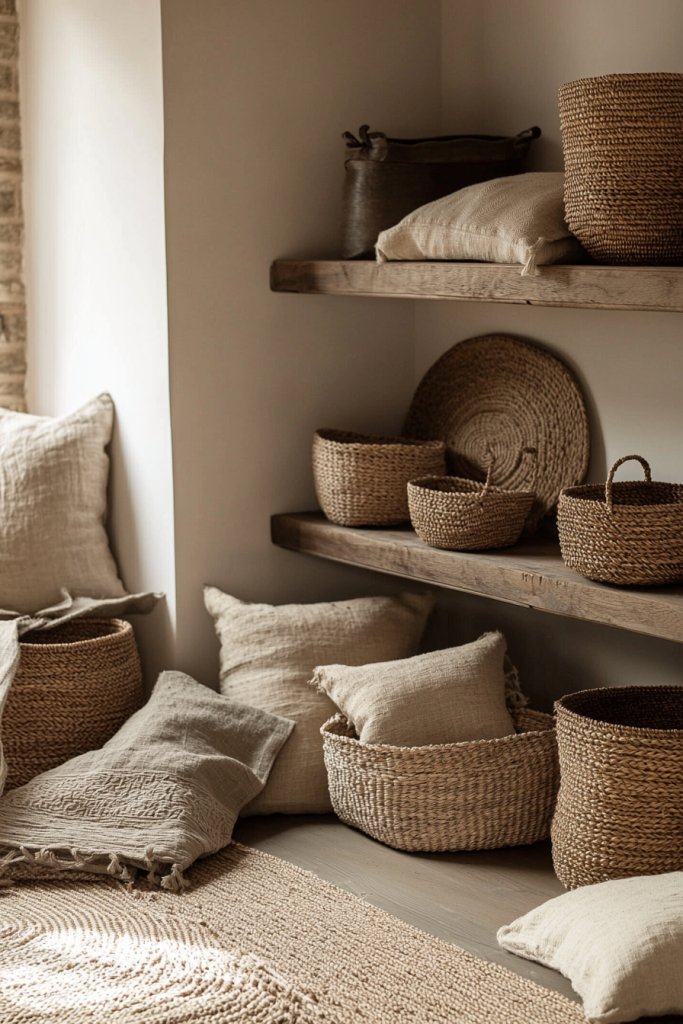
Adding handcrafted woven baskets and storage solutions is a simple yet impactful way to bring warmth and authenticity into a Wabi Sabi space. These containers often feature irregular weaves, natural fibers, and earthy tones, making each piece unique.
They can serve as stylish catchalls for everyday clutter or as decorative accents, blending seamlessly into an organic, imperfect aesthetic. Their tactile texture invites touch, and their often muted colors—like warm taupe, sandy beige, or muted greys—complement the understated palette typical of Wabi Sabi interiors.
Imagine a cozy corner with a large, handwoven jute basket filled with soft, textured throws or a set of smaller clay-colored baskets stacked neatly on open shelving. Their rustic charm adds visual interest without overwhelming the space.
The irregular patterns and natural fibers evoke a sense of handcrafted artistry, creating an inviting, lived-in atmosphere. These baskets not only look beautiful but also promote a sense of order and calm, reducing visual clutter.
To incorporate these baskets effortlessly, start by choosing sizes and styles that suit your space. You can find affordable options at local craft markets or sustainable stores, or even try DIY projects using natural materials like sisal or rattan.
Use them to organize magazines, toys, or textiles, and place them in open shelves or under side tables. Keep the look cohesive by sticking to neutral hues and simple shapes, making your space feel both functional and naturally beautiful.
17. Highlight Architectural Details with Raw, Unfinished Surfaces
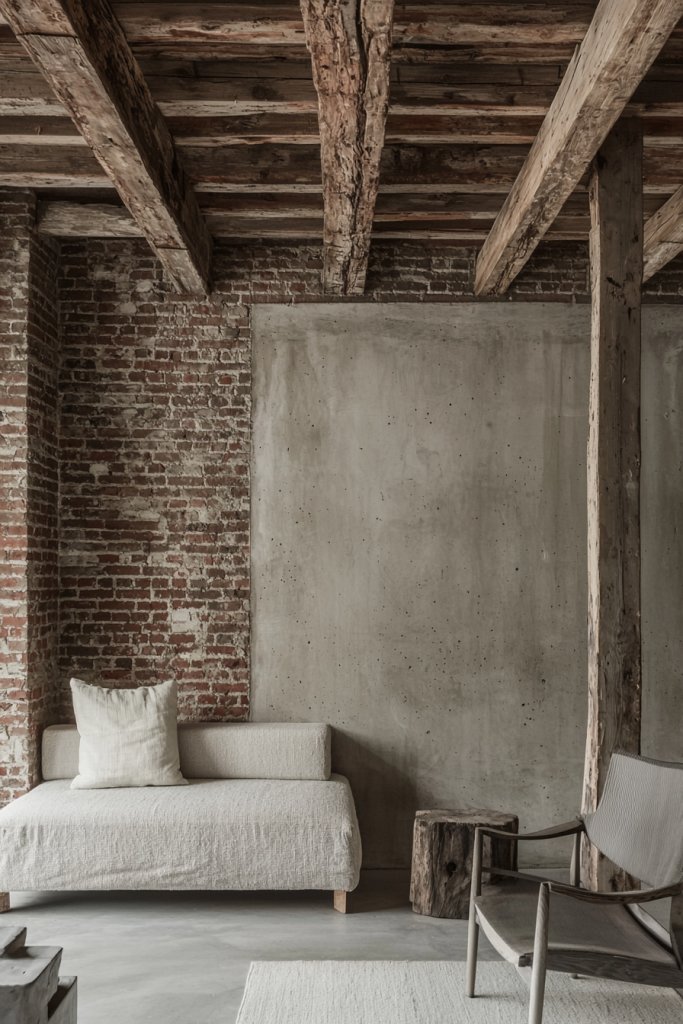
Celebrating raw architectural features is a core aspect of Wabi Sabi design, emphasizing the beauty of imperfection and natural materials. Exposed brick walls, unfinished timber beams, or concrete surfaces bring a sense of authenticity and rugged charm to a space.
These elements serve as focal points that add texture, depth, and a tactile quality, grounding the room and anchoring its organic aesthetic. Picture a living area with a partially exposed brick wall in warm terracotta tones, paired with rough-hewn wooden ceiling beams that show visible grain and knots.
The concrete floor retains its natural, unpolished finish, revealing subtle imperfections and variations. These raw surfaces evoke a sense of history and craftsmanship, inviting you to appreciate the space’s natural character.
The tactile contrast between rough textures and softer textiles enhances the sensory richness, creating a space that feels both grounded and serene. To highlight these architectural details, start by choosing existing features like brick or concrete, or consider adding them through DIY projects—such as patching a wall with plaster for an intentionally imperfect finish or exposing structural beams during renovation.
Keep the surrounding decor minimal to let the raw surfaces stand out, and complement them with simple textiles and handcrafted objects. This approach celebrates imperfection as beauty, making your home feel authentic and full of quiet soul.
18. Create Cozy Nooks with Low Seating and Soft Textiles
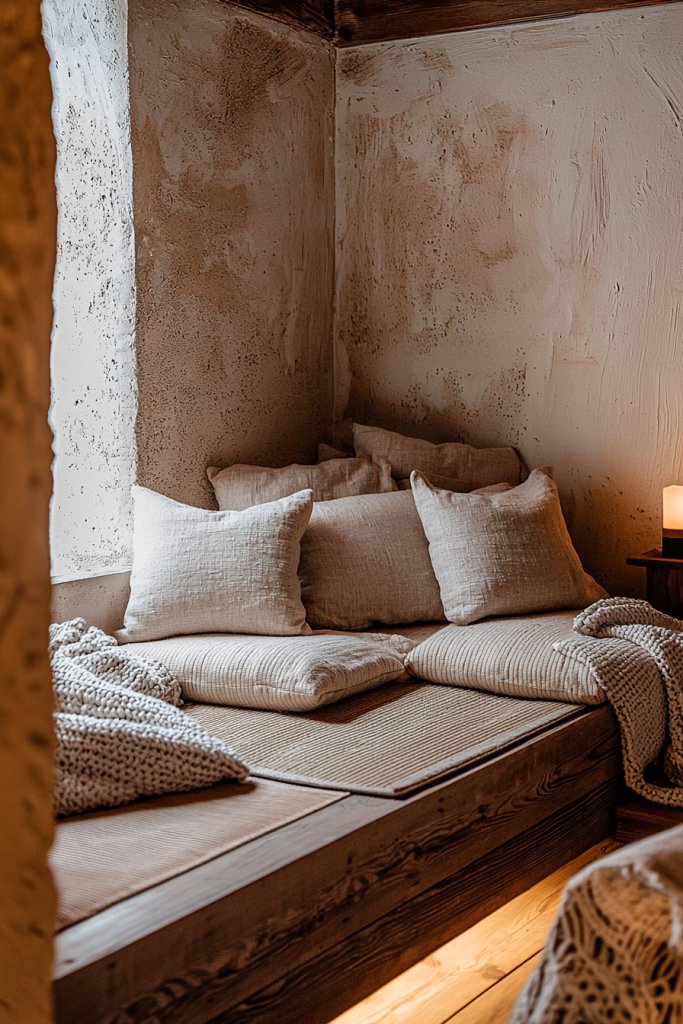
Designing intimate, cozy corners with low seating and plush textiles fosters a sense of calm and mindfulness, perfectly aligning with Wabi Sabi principles. These nooks invite relaxation, reflection, and a moment of pause amidst the simplicity of the environment.
Recommended Products to replicate this idea
| # | Preview | Product | |
|---|---|---|---|
| 1 |

|
Meditation Floor Pillow Set of 2, Square Large Pillows Seating for Adults, Tufted Corduroy... | Check Latest Price |
| # | Preview | Product | |
|---|---|---|---|
| 1 |

|
Sawmill Long Wood Bench, 43" Farmhouse Entryway Bench for Living Dining Room, Rustic Entry Way... | Check Latest Price |
Think of a low wooden bench or floor cushions paired with textured throws, creating a welcoming space that encourages grounding and comfort. Visualize a corner with a soft, cream-colored cushion on a tatami mat, layered with a chunky-knit throw in subdued earth tones.
Add a few mismatched pillows with textured fabrics—like linen, wool, or handwoven cotton—to enhance tactile richness. The space might include a small side table made of reclaimed wood and dim, diffused lighting to amplify the tranquil ambiance.
The overall effect is an inviting retreat that feels both humble and nurturing, emphasizing comfort and authenticity. To create your own cozy nook, select low furniture such as a simple wooden bench, large floor cushions, or a pouf.
Incorporate natural textiles like a wool blanket or linen pillow covers with slight imperfections. Position your corner in a quiet corner or near a window with soft, natural light.
Finish with a warm, ambient lamp or candle, and keep the surroundings minimal to preserve a sense of spaciousness. This small sanctuary will become a perfect spot for quiet moments, meditation, or reading.
19. Use Natural Fiber Rugs to Add Subtle Pattern and Texture
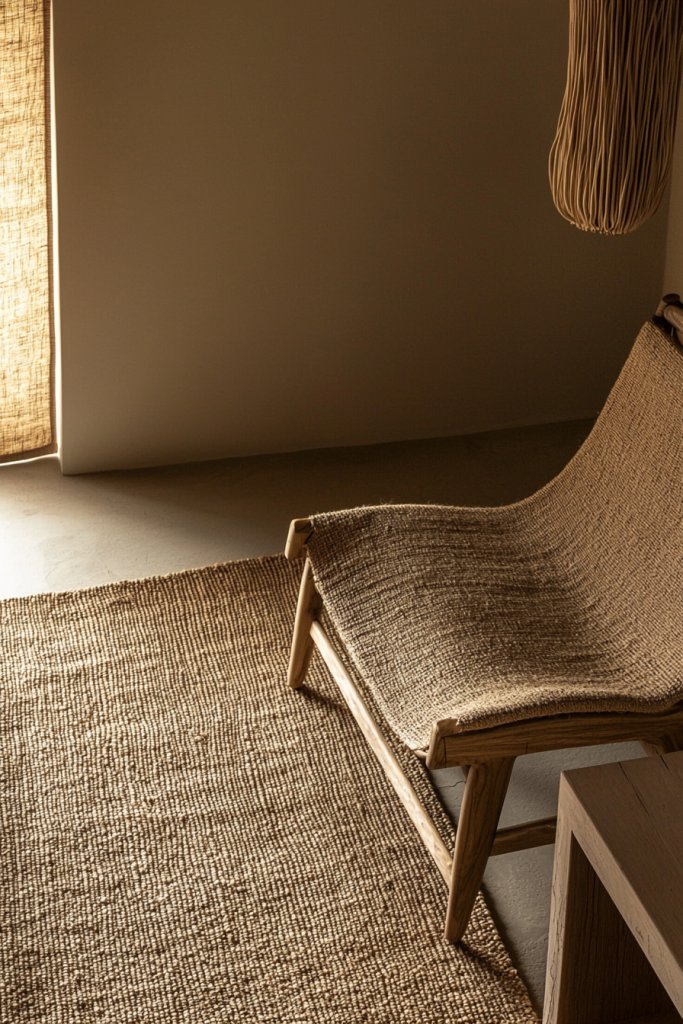
Natural fiber rugs are a foundational element in Wabi Sabi interiors, offering understated pattern, warmth, and tactile interest. Made from materials like jute, sisal, hemp, or hemp blends, these rugs bring an organic, earthy feel that grounds a space and enhances its imperfect beauty.
Recommended Products to replicate this idea
| # | Preview | Product | |
|---|---|---|---|
| 1 |

|
S & L Homes Jute Cotton Hand Woven Natural Farmhouse Area Rug for Living Room - Rustic Vintage... | Check Latest Price |
| # | Preview | Product | |
|---|---|---|---|
| 1 |

|
S & L Homes Jute Cotton Hand Woven Natural Farmhouse Area Rug for Living Room - Rustic Vintage... | Check Latest Price |
Their neutral tones—such as sandy beige, warm brown, or muted greys—blend seamlessly with other natural elements, creating a cohesive, calming environment. Imagine walking barefoot across a jute rug with a loose, open weave, its textured surface inviting gentle tactile feedback.
The subtle irregularities in the weave and color variation add visual depth without overwhelming the senses. These rugs can define a seating area, add softness underfoot in a hallway, or serve as a neutral backdrop for ceramics and handcrafted textiles.
Their organic appearance complements other raw and imperfect materials, elevating the overall harmony of the space. To incorporate natural fiber rugs, choose sizes that suit your layout—such as a runner, rectangle, or round shape—and layer them over polished floors or tatami mats.
For budget-friendly options, look for sustainable brands or secondhand sources. Maintain their natural look by avoiding overly synthetic treatments, and pair them with other textured textiles and simple furniture. These rugs subtly reinforce the Wabi Sabi ethos of natural beauty and imperfect perfection.
20. Incorporate Wabi Sabi-Inspired Decorative Sculptures or Objects
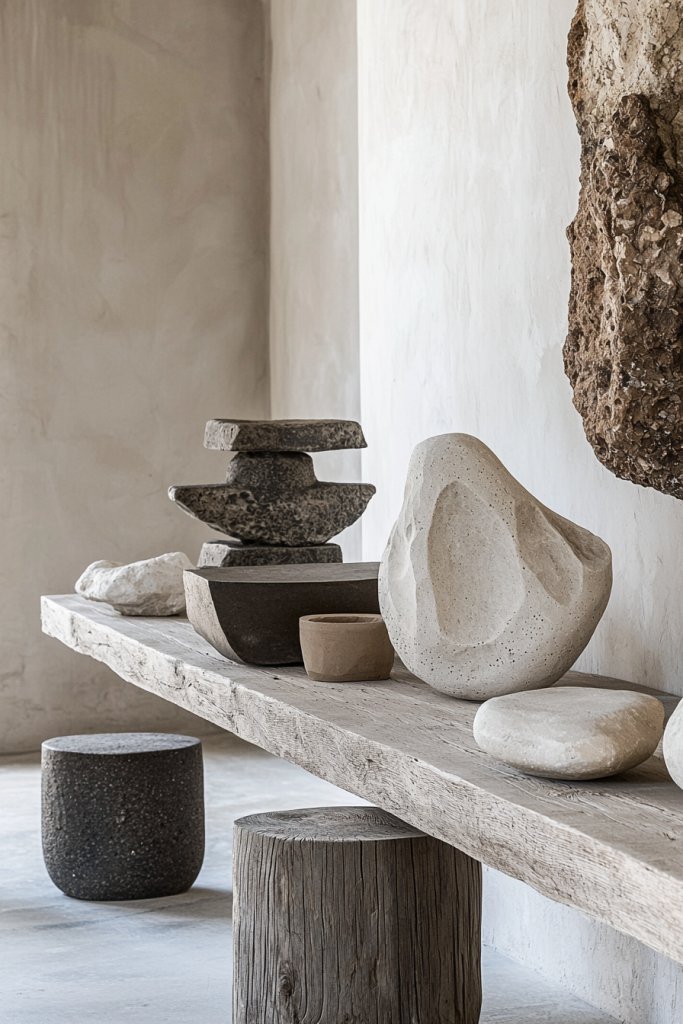
Adding handcrafted sculptures and organic objects is a wonderful way to embody Wabi Sabi’s celebration of natural forms and imperfection. These pieces can be made from stone, clay, or metal, featuring irregular shapes, rough textures, and earthy tones.
Recommended Products to replicate this idea
| # | Preview | Product | |
|---|---|---|---|
| 1 |

|
Ozzptuu Sandstone Resin Thinker Style Abstract Sculpture Statue Collectible Figurines Home Office... | Check Latest Price |
| # | Preview | Product | |
|---|---|---|---|
| 1 |

|
Rustic Vases for Home Decor. Ceramic Vase for Dining Table Decor. Terracotta Decorative Vase... | Check Latest Price |
They serve as focal points or accents that evoke a sense of quiet strength and natural beauty, encouraging mindfulness and appreciation for simplicity. Picture a small, asymmetrical stone sculpture on a shelf, its surface weathered and uneven, radiating a sense of natural history.
Or imagine a roughly textured clay vessel, intentionally imperfect, holding a single dried flower or simply standing alone as a sculptural element. These objects become visual anchors that invite closer inspection and reflection, adding depth and authenticity to your decor.
Their unrefined qualities foster a peaceful, contemplative atmosphere. To incorporate these sculptures, visit artisan markets or craft shops specializing in handmade objects, or explore DIY options using clay or natural stone.
Place them on open shelves, side tables, or in quiet corners where they can be appreciated up close. Keep the arrangement minimal to emphasize their unique qualities, and select pieces that resonate personally, creating a space filled with meaningful, imperfectly perfect accents that embody Wabi Sabi’s essence.
21. Opt for Unfinished or Reclaimed Wood Shelves and Surfaces
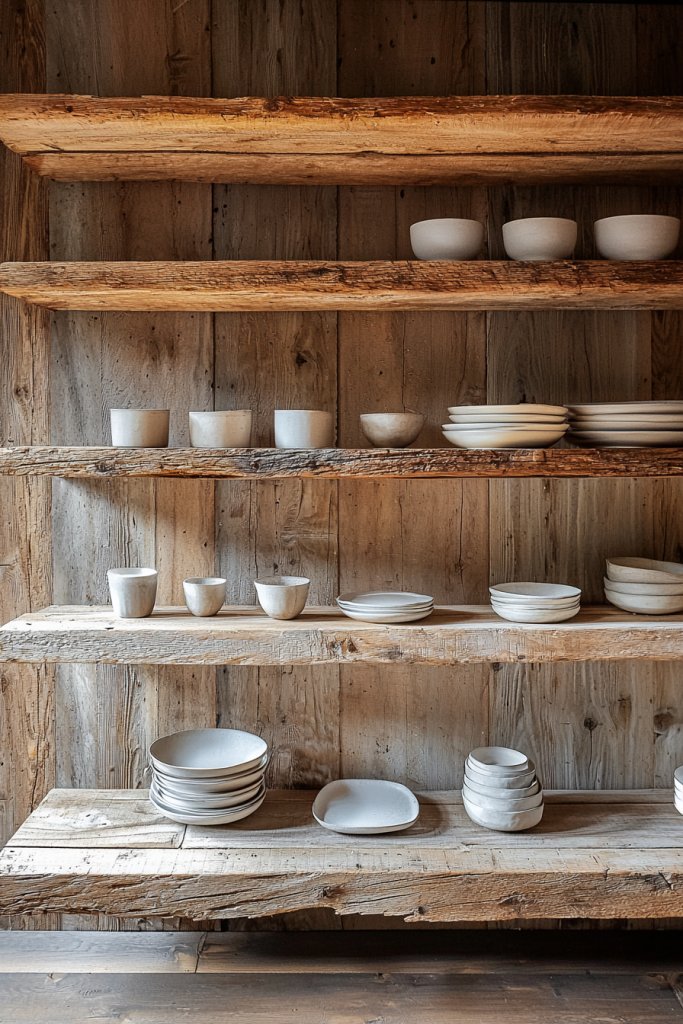
Adding unfinished or reclaimed wood shelves instantly introduces a raw, organic charm that embodies the essence of wabi sabi. These shelves often feature natural knots, uneven edges, and weathered textures, creating a beautifully imperfect backdrop for your decor.
Their warm, earthy tones—ranging from soft browns to greyish hues—bring a calming, grounded feel to any room. As light hits their rough surfaces, you can almost feel the history and craftsmanship embedded in each piece, inviting a tactile appreciation and a sense of authenticity.
Imagine a living space where open shelves made from reclaimed pallet wood display simple ceramics, handmade candles, or vintage books. The rough grains and slight imperfections contrast beautifully with smooth, minimalist objects, creating a balanced visual harmony.
These shelves don’t need to be perfectly aligned; their asymmetry adds to the charm, making the space feel more inviting and lived-in. The natural scent of aged wood can subtly enhance the sensory experience, reinforcing the connection to nature and imperfection.
To recreate this look, start by sourcing reclaimed wood from salvage yards or eco-friendly suppliers—look for pieces with visible knots, grain variations, and weathered surfaces. If DIY isn’t your thing, many stores sell unfinished or distressed wood planks that can be easily mounted.
Use simple brackets or even floating designs for a minimalist effect. Sand rough edges lightly if needed but leave intentional imperfections intact for authenticity. Pair your shelves with handmade ceramic vases or woven baskets to complete the organic aesthetic.
22. Maintain a Balance of Empty Space for Visual Calmness
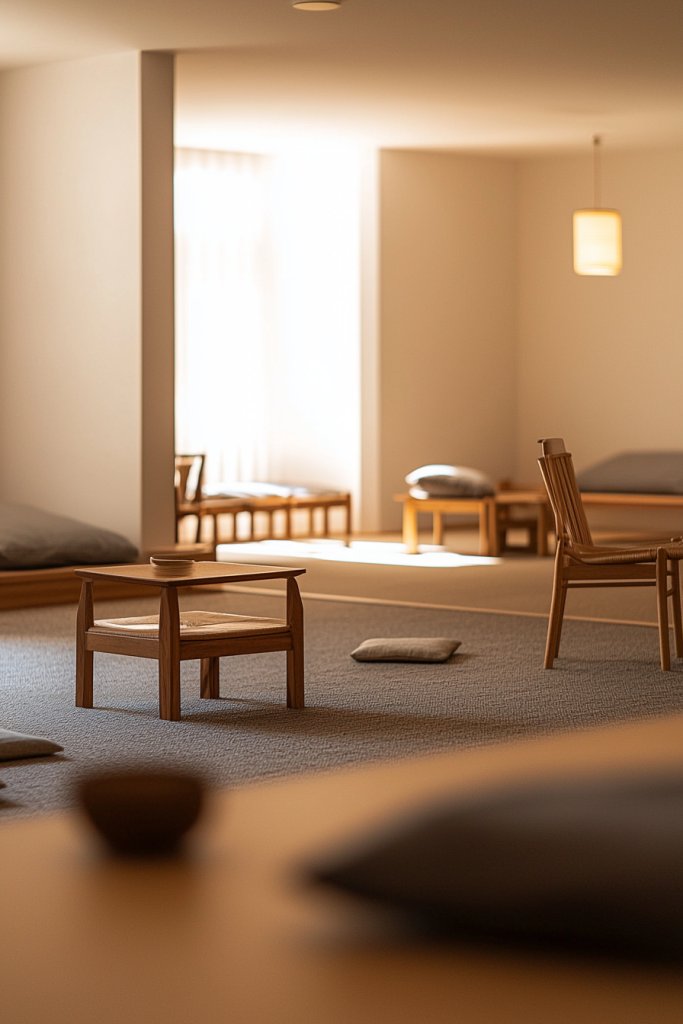
Creating a sense of serenity in a wabi sabi-inspired interior often hinges on thoughtfully managing empty space, allowing the eye to rest and breathe. Strategic placement of furniture and decor ensures the room feels open, uncluttered, and calming—key elements of wabi sabi’s understated beauty.
Recommended Products to replicate this idea
| # | Preview | Product | |
|---|---|---|---|
| 1 |

|
Flamaker Futon Sofa Bed Modern Folding Futon Set Convertible Recliner Lounge for Living Room with... | Check Latest Price |
| # | Preview | Product | |
|---|---|---|---|
| 1 |

|
Vanselia Ceramic Flower Vase Home Decor - Large Farmhouse Table Vases Rustic Vintage Living Room... | Check Latest Price |
Rather than filling every inch, leaving areas intentionally sparse emphasizes the natural textures and imperfect objects, enhancing their beauty and creating a peaceful atmosphere. Visualize a room with a low-profile, simple sofa positioned against a textured wall, with only a few carefully curated objects—like a handcrafted ceramic vase or a softly textured throw—placed sparingly.
The uncluttered space invites mindfulness and reflection, as your gaze naturally rests on each element without overwhelm. The balance of filled and empty areas encourages a flow that feels both harmonious and effortless, making the space feel larger and more serene.
Subtle shifts in light and shadow across these open areas deepen the sense of calm. Implementing this principle involves assessing your space and editing out excess decor or furniture that doesn’t serve a purpose.
Start by removing non-essential items and spacing remaining pieces apart to avoid crowding. Use negative space intentionally to highlight your favorite textures and objects—think of it as visual silence that enhances overall harmony. Be patient; creating this balance takes time, but the result is a room that feels peaceful, authentic, and inviting, encouraging relaxation and mindfulness.
23. Curate a Collection of Natural, Handcrafted Decor Items
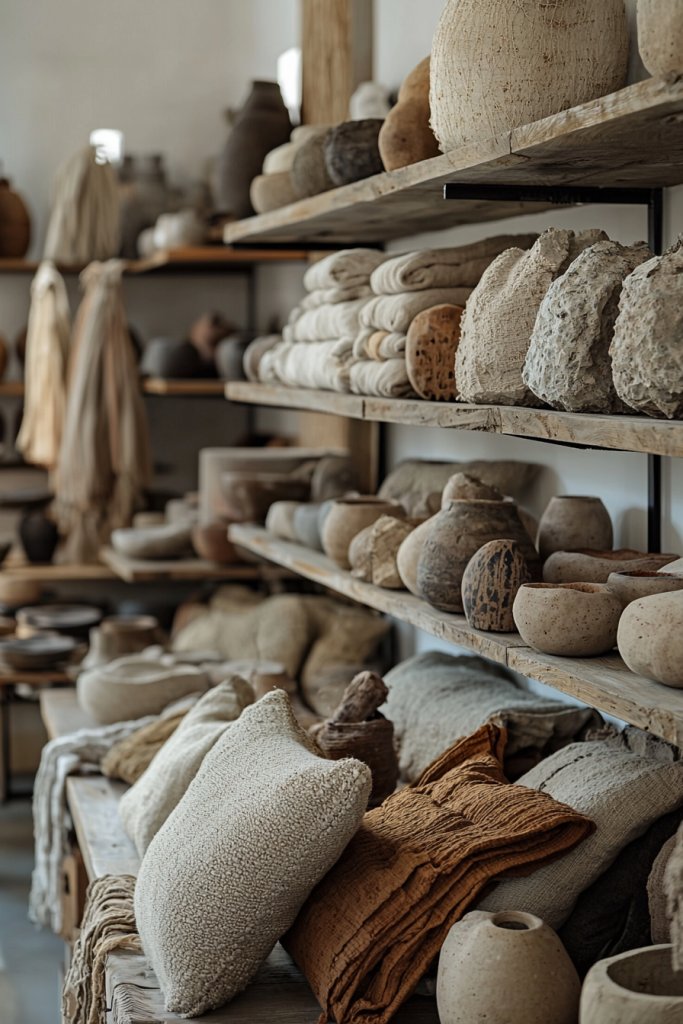
A thoughtfully assembled collection of natural, handcrafted decor elevates the wabi sabi aesthetic by showcasing the beauty of imperfection and artisanal craftsmanship. Incorporate items like irregular ceramic vessels, textured linen cushions, or rough-hewn wooden sculptures—each piece tells a story of nature and human touch.
Recommended Products to replicate this idea
| # | Preview | Product | |
|---|---|---|---|
| 1 |

|
Vanselia Ceramic Flower Vase Home Decor - Large Farmhouse Table Vases Rustic Vintage Living Room... | Check Latest Price |
| # | Preview | Product | |
|---|---|---|---|
| 1 |

|
NOVICA Romantic Wood Sculpture, Brown, 8" Tall 'Eternity Of Love' | Check Latest Price |
Arranged carefully, these objects create a curated yet relaxed display that exudes warmth, authenticity, and a sense of mindfulness. Picture a corner adorned with a mix of handmade pottery in muted earth tones—perhaps a small, asymmetrical bowl, a textured vase, and a rustic tray—paired with a chunky knit throw or a woven basket.
The imperfections—slight asymmetry, uneven glaze, or natural variations—are what make each piece unique and captivating. Together, they form a tactile tapestry that invites touch and contemplation, encouraging a deep appreciation for craftsmanship and the natural world.
To build this collection, visit local artisan markets or browse online shops specializing in handmade decor. Focus on selecting pieces with organic textures, muted colors, and irregular shapes that resonate with the wabi sabi philosophy.
Mix and match different materials—clay, wood, linen—to create visual interest, but keep the overall palette subdued for harmony. Display your collection on open shelves, countertops, or in a dedicated nook, arranging items in a seemingly casual yet intentional manner to evoke a sense of effortless beauty.
Conclusion
Embracing the beauty of imperfection, natural materials, and simple, thoughtful arrangements can transform your space into a serene sanctuary rooted in wabi sabi. From textured walls and weathered furniture to handcrafted ceramics and reclaimed wood accents, these ideas encourage authenticity and mindful living.
By incorporating these elements, you’ll create an environment that fosters calmness, warmth, and genuine beauty. Start infusing your home with these principles today and discover the peaceful harmony that wabi sabi can bring to everyday life.
Last update on 2025-09-20 / Affiliate links / Images from Amazon Product Advertising API
Leave a Reply